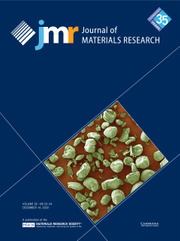Crossref Citations
This article has been cited by the following publications. This list is generated based on data provided by
Crossref.
Garc�a, J.A.
Rem�n, A.
Zubiaga, A.
Mu�oz-Sanjos�, V.
and
Martinez-Tom�s, C.
2002.
Photoluminescence Study of ZnSe Single Crystals Obtained by Solid Phase Recrystallization under Different Pressure Conditions. Effects of Thermal Treatment.
physica status solidi (a),
Vol. 194,
Issue. 1,
p.
338.
Tarrant, R.N
Fujisawa, N
Swain, M.V
James, N.L
McKenzie, D.R
and
Woodard, J.C
2002.
PBII deposition of thick carbon coatings from a cathodic arc plasma.
Surface and Coatings Technology,
Vol. 156,
Issue. 1-3,
p.
143.
Xu, Tao
Yang, Shengrong
Chen, Miao
Tian, Jun
Xue, Qunji
Li, Jingqi
and
Guo, Wantu
2002.
Influence of nitrogen ion implantation on tribological properties of nanocrystalline diamond films.
Journal of Physics D: Applied Physics,
Vol. 35,
Issue. 8,
p.
788.
Chua, Daniel H.C.
Milne, W.I.
Yu, L.J.
Sheeja, D.
and
Tay, B.K.
2003.
Fabrication and Simulation of Amorphous Carbon Cantilever Structures.
MRS Proceedings,
Vol. 773,
Issue. ,
Koshel, D
Ji, H
Terreault, B
Côté, A
Ross, G.G
Abel, G
and
Bolduc, M
2003.
Characterization of CFx films plasma chemically deposited from C3F8/C2H2 precursors.
Surface and Coatings Technology,
Vol. 173,
Issue. 2-3,
p.
161.
Sheeja, D.
Tay, B.K.
Sze, J.Y.
Yu, L.J.
and
Lau, S.P.
2003.
A comparative study between pure and Al-containing amorphous carbon films prepared by FCVA technique together with high substrate pulse biasing.
Diamond and Related Materials,
Vol. 12,
Issue. 10-11,
p.
2032.
Sheeja, D
Tay, B.K
Yu, L.J
Chua, D.H.C
Milne, W.I
Miao, J
and
Fu, Y.Q
2003.
Fabrication of amorphous carbon cantilever structures by isotropic and anisotropic wet etching methods.
Diamond and Related Materials,
Vol. 12,
Issue. 9,
p.
1495.
Sheeja, D
Tay, B.K
Krishnan, S.M
and
Nung, L.N
2003.
Tribological characterization of diamond-like carbon (DLC) coatings sliding against DLC coatings.
Diamond and Related Materials,
Vol. 12,
Issue. 8,
p.
1389.
Tay, B.K
Sheeja, D
and
Yu, L.J
2003.
On stress reduction of tetrahedral amorphous carbon films for moving mechanical assemblies.
Diamond and Related Materials,
Vol. 12,
Issue. 2,
p.
185.
Takeda, Satoshi
and
Suzuki, Susumu
2004.
Improved adhesion of amorphous carbon thin films on glass by plasma treatment.
Journal of Vacuum Science & Technology A: Vacuum, Surfaces, and Films,
Vol. 22,
Issue. 4,
p.
1297.
Zhang, Xu
Wu, Zhenglong
Wu, Xiangying
Qin, Lizhao
Yu, Xiang
Xu, Yuanzhi
and
Zhang, Huixing
2007.
Structure and properties of tetrahedral amorphous carbon films implanted with Ti ion.
Surface and Coatings Technology,
Vol. 201,
Issue. 9-11,
p.
5219.
Alakoski, Esa
Tiainen, Veli-Matti
Soininen, Antti
and
Konttinen, Yrjö T
2008.
Load-Bearing Biomedical Applications of Diamond-Like Carbon Coatings - Current Status.
The Open Orthopaedics Journal,
Vol. 2,
Issue. 1,
p.
43.
Sankaran, K.J.
Joseph, P.T.
Tai, N.H.
and
Lin, I.N.
2010.
High dose N ion implantation effects on surface treated UNCD films.
Diamond and Related Materials,
Vol. 19,
Issue. 7-9,
p.
927.
Varghese, Jobin
Gopinath, Sumesh
and
Sebastian, Mailadil Thomas
2013.
Effect of glass fillers in Cu2ZnNb2O8 ceramics for advanced microwave applications.
Materials Chemistry and Physics,
Vol. 137,
Issue. 3,
p.
811.
Pu, Jibin
Zhang, Guangan
Wan, Shanhong
and
Zhang, Renhui
2015.
Synthesis and characterization of low-friction Al-DLC films with high hardness and low stress.
Journal of Composite Materials,
Vol. 49,
Issue. 2,
p.
199.
Balla, Vamsi Krishna
Das, Mitun
Datta, Someswar
and
Kundu, Biswanath
2015.
Processing Techniques and Tribological Behavior of Composite Materials.
p.
218.
Xie, Jun
and
Komvopoulos, Kyriakos
2016.
Bilayer amorphous carbon films synthesized by filtered cathodic vacuum arc deposition.
Journal of Materials Research,
Vol. 31,
Issue. 20,
p.
3161.
Paul, Rajib
2017.
Uniformly dispersed nanocrystalline silver reduces the residual stress within diamond-like carbon hard coatings.
Nano-Structures & Nano-Objects,
Vol. 10,
Issue. ,
p.
69.
Balla, Vamsi Krishna
Das, Mitun
Datta, Someswar
and
Kundu, Biswanath
2018.
Biomedical Engineering.
p.
859.
Guo, Shuai
Yang, Lei
Dai, Bing
Geng, Fangjuan
Ralchenko, Victor
Han, Jiecai
and
Zhu, Jiaqi
2020.
Past Achievements and Future Challenges in the Development of Infrared Antireflective and Protective Coatings.
physica status solidi (a),
Vol. 217,
Issue. 16,

